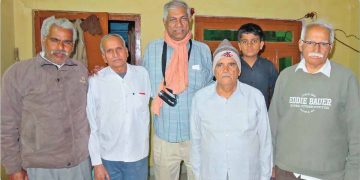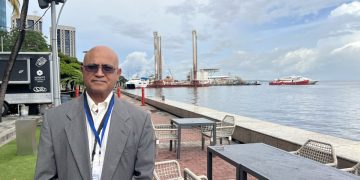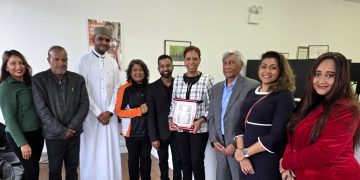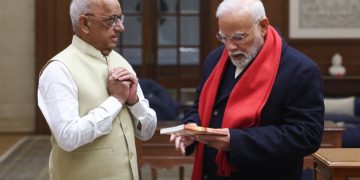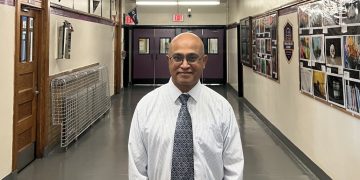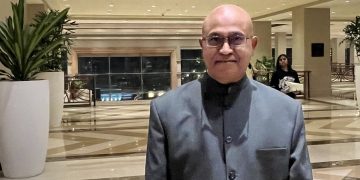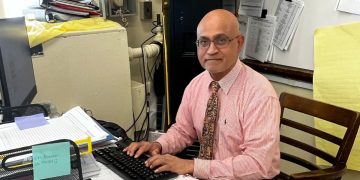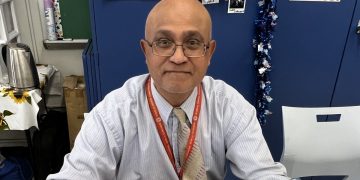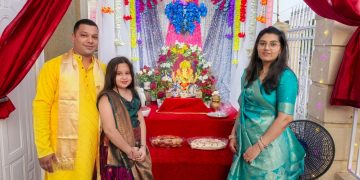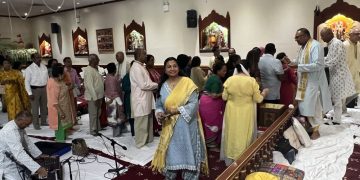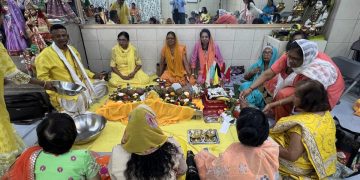Intense emotional and cultural rejuvenation was the discovery of my paternal grandfather’s (Ajah) family in India in February 2016 after 104 years. Ramkarran Sukul (Ajah) migrated to British Guiana in 1912 and was indentured to Nonpareil-Enterprise. He emerged as the plantation’s first Arya Samaj Pandit. He also became the head driver of Enmore Sugar Estates i.e. Enmore to Lusignan. Why did he leave India? The renunciate Brahmin reportedly skirted family complications after his father, Cheddu, remarried, on the passing of his mother. Ramchand, born of his father’s second marriage was listed on his immigration pass as next of kin. Ajah had apparently also distanced himself from his Sanatani origins long before he came to British Guiana.
My maiden trip to India turned out successful beyond my wildest expectations. Many significantly joyous reconnections also occurred with other people in India including industrialist Darshan Singh, a Sikh; Mayanne Krech, the Chinese American alter ego of the late Vedic Missionary to British Guiana, Pandit Usharbudh Arya (1956-1962) later Swami Veda Bharati, and, Vedic Pracharak to the USA, Yashpal Shastri, all of whom I had developed friendships but subsequently lost contact. I also visited Om Prakash, the son of Professor Bhaskarananda. MA, LLB. The latter was Grand Vedic Missionary to British Guiana (1936-1945). In New Delhi, I was also fortunate to encounter a very intelligent and most dynamic, rejuvenating Arya Samaj leader in Vinay Arya.
My research into my ancestry started with a faded group photograph of Ajah’s Arya Samaj Pandit friends, taken in India during his return visit in 1947. By itself, was not adequate. Fate soon intervened to make a difference. Destiny was getting Ajah’s immigration pass just before I left in January to attend the scheduled February Indian wedding of an excellent Sikh family (Gurbachan Singh’s) US-born son, Mandeep who grew up among New York Guyanese.
How did I find Ajah’s immigration pass? Rampersaud Tiwari, 84 of Canada, originally from Nonpareil (had moved to Buxton, then to Annandale in the 1960s) who had served as the Assistant Secretary of the cabinet of the 1960s PPP government had informed me that my Ajah as Nonpareil-Enterprise’s first Arya Samaj Pandit was also his spiritual Guru. Tiwari owned a 1947 book authored by Professor Bhaskarananda in which Ajah had written the foreword in Hindi. Both Professor and my Ajah had the same Guru in India and on meeting up again in British Guiana the linkages were rekindled. Just a few months before I was due to visit India, Tiwari retrieved and sent me an English translation of the foreword. Clues led to the exact year of Ajah’s departure (1912) with the ship traced as the Chenab. On a well-timed trip to Guyana Tiwari again, fortunately, retrieved the immigration pass which detailed Ajah’s father’s name (Cheddu), his village of origin (Ramnagar), his next of kin (Ramchand) the thana ie police district (Kandauli) and the district of the village, ie Agra where the celebrated Taj Mahal is located. With all the critical immigration details now in hand, I was more excited. Obviously, the next step was identifying which Ramnagar village in India was the correct place of origin. There were several across India. But since only one Ramnagar village existed in Agra district it became the beckoning beacon of hope. Armed with the detailed immigration pass information, the 1947 photograph of Ajah with his many Indian friends listed by name, and, combined with the intelligence of two enthusiastic Indian friends, the ensuing drama came alive like a movie. The photo however had no specific address to go to.
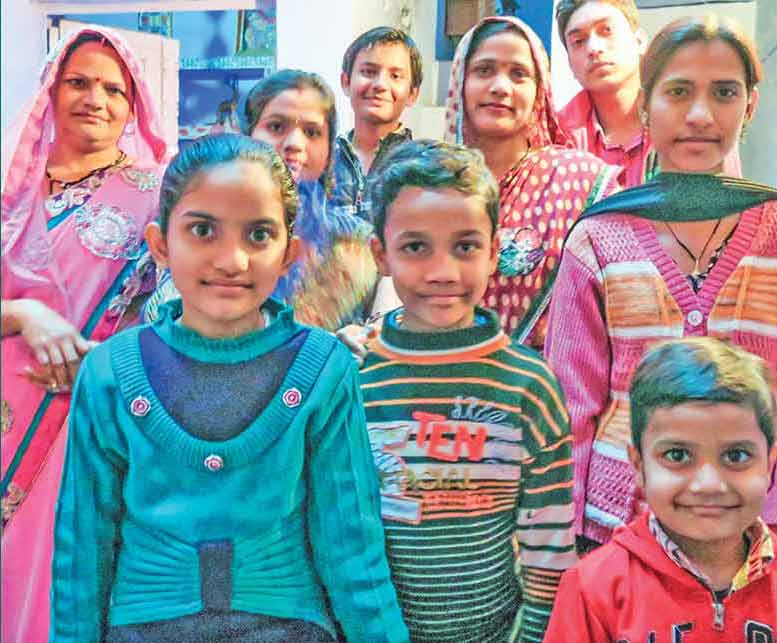
Infectious bubbling excitement was the thrill of the hunt in accompanying the two Indian sleuths to whom I am most grateful for demystifying my ancestry. My Agra hosts, the witty retired physician Dr. Radhakishan Varma,65, as Sherlock Holmes and his handsome movie star nephew Ravi Verma, 45, acting as the capable John Watson were excellent in action. Both spoke fluent English. I spoke no Hindi. Finding someone in Ramnagar who could identify anyone in the photograph was the key to the mystery. I videotaped the entire episode with Dr Varma and Ravi as excited as we all were. I was advised to remain silent lest my accent betrays the quest. I did. I couldn’t laugh in Hindi so I didn’t. Dr. Verma’s intelligence, humor, patience, and meticulous analysis was inspirationally refreshing in its application.
Speaking to about five people on Ramnagar’s main market street yielded no results. We were eventually directed to go inside the village itself to try our luck. By their persistence in the gathering of clues, both sleuths skillfully made touchdown contact. When the lost treasure was found, the word later quickly spread in Ramnagar that the Shuklas “British Guiana American” lost relative was in their midst.
I was thrilled to meet my cousin Bhagwan Swaroop Shukla who was the grandson of my Ajah’s brother Ramchand. The latter was listed in his immigration pass as next of kin. Soon I was literally gasping for breath by the prolonged two-day tsunami outpouring of awestruck engulfing love, admiration, and smothering respect such as I have not experienced a long time. But I quickly recovered after sundown’s rapid onset on the first day’s contact. The challenge to nighttime travel back to my host’s Agra’s home where I was also being treated as a special guest required precautionary nighttime traffic sensitivity.
Initially, I had briefly met only one-third of the Shuklas by the family tree sketched by a detective “Ravi Watson”. I regret most sincerely being unable to include all names in this article due to space limitations. Many questions were however unanswered and besides, some of my previous nighttime photographs were not so good. Rectification required a longer daytime visit. So I returned to Ramnagar, the next day in earnest, after a whirlwind visit to the famous Taj Mahal. I had a lot of fun at this landmark. “You know what Rafeek ji. I want to buy this Taj Mahal” I said with an air of finality. Initially shocked the hired guide laughed with nervous uncertainty and replied: “But they are not selling it ji!”. “Even if they get a good price Rafeek ji”? Rafeek had a trump card. “How are you going to take it with you Ji. It’s very heavy”. “Ahh Rafeek ji” I replied. “God is great (which I said in Arabic). As a Muslim, he was very satisfied with my answer. He was also a very good cameraman and overall made my Taj Mahal visit very pleasant for which he was handsomely compensated.
On the second visit to Ramnagar, my dignified and handsome third cousin Bhagwan Swaroop and entourage met my taxi on the busy market’s main street where all the previous days investigations were conducted. Quickly the Hindi language gap was overcome by an interpreter. During this second visit, I was taken to the unpaved equivalent of Georgetown’s open air Bourda Market. There I met many of the rest of the available extended Shukla family. I photographed them all next to their individual shops after emotional greetings and hugs. A crowd would gather to watch the photography sessions. “What is going on” obviously spoken in Hindi was met by a cousin Bhagwan Swaroop’s reply in English “He is our family from British Guiana America!”
Afterwards, cousin Bhagwan Swaroop invited me to visit their Ramnagar village home. Refusal is not an option in any such circumstances as they would have been very hurt. At their modest home a huge crowd of standing, gawking curious neighbours and family members, semi surrounded me as I sat inside with cousins Bhagwan and his dark skinned younger brother Prem on either side. A stream of female relatives all heads covered poured out from their compound and paid their respects by touching my feet in traditional Indian salutation. I accepted it as the cultural norm in India. Again I was overwhelmed and touched with their overflowing love and affection. “Aren’t you staying tonight?” a female asked in English. I explained why I could not and the disappointment was obvious. “Have something to eat” was the request. “Black tea without milk and sugar would be good”. They brought a tray full of finger food, sweet biscuits, etc, and a full cup of tea containing milk and sugar. Apparently black tea alone was not in their welcome wagon for a lost 104 years ago relative. Unable to consume so many delicious goodies I shared it out to the crowd like prashad.
It became obvious that Bhagwan Swaroop was the functional patriarch of the entire Shukla family in Ramnagar from what I observed. Age has always traditionally carried a lot of weight in Indian society and the handsome, intelligent and neatly dressed patriarch carried it with dignity. When I was walking to my waiting taxi I asked the unmarried entourage of males if they had girlfriends. Many smiled until a voice spoke up and said they will not acknowledge it in the presence of their respected elderly uncle.
Initially, cracking the case hinged on locating a preteen boy, Mohan Babu, included and named in the 1947 photograph which Ajah had brought back from India. While initially driving to Ramnagar from Agra I suggested we target finding that “youth” ( sure to be older and if alive certain) to be pivotal to the mystery. After many false starts, we finally encountered Satesh Sharma, Ramnagar’s retired village headman who became the pivotal deal breaker. He knew some of the people in the photograph! I could feel the excitement building even though I did not understand any of the Hindi. I whispered to Ravi to confirm it and he did. Mohan Babu the “youth” was alive. It was to his home where Satesh took us.
The “youth,” now 71 years old, was a treasure house of information about my entire Shukla family tree in Ramnagar. His Arya Samaj Pandit father in the 1947 photo and my Ajah were apparently very good friends. Apparently, Mohan Babu had become very familiar with my Ajah’s history through him. He gave precise detailed information. He revealed the correct family surname was “Shukla” and knew why Ajah had changed it. He also revealed exactly why Ajah had left Ramnagar for British Guiana. Through Dr. Varma, he actually told me my father’s name was Sukhdev and my Agee’s name was Bechnee! He left me stunned. Ajah’s story was now clearer thanks to Mohan Babu and others.
Living in Ramnagar, he obviously knew my cousin Bhagwan Swaroop, phoned and informed him that his lost relative had come from “British Guiana America” and was at his home. On Bhagwan Swaroop’s arrival, he paid the traditional respects of touching my feet and I hugged him with excited emotional warmth most surreal. It was the most emotional and joyous sensitive reconnection after 104 years (1912-2016). My cousin said he always wondered if he had relatives overseas. Now that eternal question was finally answered by my arrival and our reconnection. Then Mohan Babu brought out his own framed copy of the same exact photo which I had brought with me to find my ancestry. His possession of the same photo was the official seal of authenticity of the ancestral link. Cousin Bhagwan’s sons Anand and Dilip also showed me the same photo at their home. The circle was now complete. There was no doubt the family links were genuine, had been strong, and were finally reconnected. Would the linkages be strengthened and nurtured? India has already had a profound humbling transformative effect on me as some have already pointed out. Would I be visiting again? Only God knows.
You may contact Vishnu Dutt at this email address: (Zindabaad66@yahoo.com)
